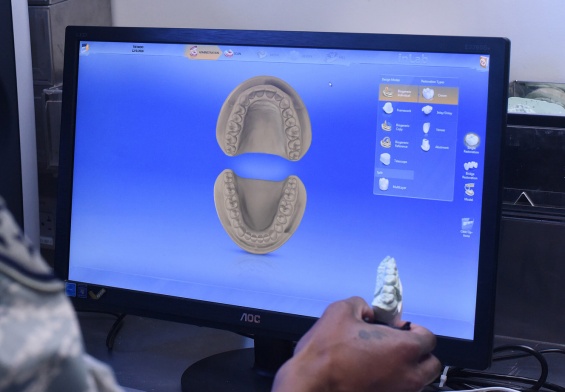A cavity in its early stages usually looks like a small white or chalky spot on the tooth surface. This coloration indicates demineralization, which means the tooth is losing minerals, the first stage of tooth decay. If it’s not treated, the white spots can get yellow, brown, and then black as the cavity gets deeper into the tooth. The earlier you detect these, the better, as cavities get more difficult and invasive to treat as they progress.
Recognizing what a cavity looks like in its early stages is a big help detecting, and thus, treating them early. You may not feel it right away, but the early white spots mean enamel is starting to break down.
In this post, you’ll learn what to look for, what those things mean, and what actions to take, including when to call your dentist.
What Do Cavities Look Like as They Progress?
White Spot Lesions: The First Warning Sign
Cavities start as white or cloudy-looking spots on the enamel before darkening as the decay deepens. These early areas of demineralization might not hurt or feel different at all, even though they’re the first visible clue.
If you’ve ever noticed a dull white patch that doesn’t brush away, it could be the start of a cavity. Over time, that white spot can:
- Turn light brown as enamel breaks down
- Become dark brown or black as decay reaches deeper layers
- Lead to pain or sensitivity if it gets close to the nerve
Next time you brush, look closely at any spot that doesn’t match the rest of your enamel. If it’s rough, chalky, or changing color, it’s time to ask a dentist.
White spots are your early warning system. Don’t wait for them to turn brown or black.
Color Progression Timeline
- Stage 1: White or chalky spots (enamel demineralization)
- Stage 2: Light yellow or tan discoloration (initial enamel breakdown)
- Stage 3: Light brown areas (decay entering deeper enamel)
- Stage 4: Dark brown or black spots (significant decay progression)
Where to Look for Cavities
Early cavities show up in spots that brushing and flossing might miss, because that’s where food and bacteria are most likely to hide. You might not notice anything at first, but these areas are usually where problems start.
High-Risk Areas for Cavity Formation
If you’re checking your own teeth, here’s where to look:
- Between your teeth: This is a common issue; make sure to floss
- On the grooves of molars: Run your tongue over your back teeth, feeling for any sticky spots
- Near the gumline: Especially around hard-to-reach areas on the inside of your mouth
- On exposed roots: If your gums have receded, these softer surfaces are more vulnerable
Early cavities in kids often start on the upper front teeth near the gumline. This is usually caused by drinking from bottles or sweet/sugary drinks.
Don’t just look for cavities on top of the teeth. Decay can hide in the corners, between teeth, and near the gums.
Age-Specific Cavity Patterns
- Children: Look for white spots along gumlines of front teeth (baby bottle decay)
- Teenagers: Check between teeth and deep grooves in molars where food particles hide
- Adults: Check exposed root surfaces and areas around old fillings
- Seniors: Watch receding gumlines where softer root surfaces become vulnerable
How to Spot the Difference Between Healthy and Decaying Teeth
You can usually tell the difference between a normal tooth and early decay by checking for texture, shine, and color. Healthy enamel is smooth and glossy. Early cavities look dull and may feel rough or sticky.
Visual Identification Checklist
Use this checklist:
- Normal enamel – Glossy, smooth, consistent in color
- Early cavity – Chalky white or matte brown spot that feels rough
- Old or arrested cavity – Dark but smooth and clean, possibly inactive
Rub your tongue over a problem spot. Does it feel different from the rest of your teeth? Is it rough, sticky, or dull instead of shiny under light? If so, it’s possibly decay.
It’s easier to feel surface changes than see them. Trust your tongue and follow up if something seems off.
Texture Changes in Early Decay
- Healthy tooth: Slick, smooth surface under tongue
- Early cavity: Slightly rough or tacky feeling
- Progressing cavity: Definitely rough, may catch floss or fingernail
How Can You Tell How Deep a Cavity Is?
Even if a cavity looks small, decay can spread underneath the surface before you realize it. That little white or brown spot might hide deeper breakdown in the tooth’s structure.
The Invisible Progression of Decay
When acids penetrate your enamel, they reach the softer dentin layer underneath. Dentin has tiny tunnels that lead straight to the nerves. This is why decay here can suddenly feel sensitive or painful.
Dentists can spot this earlier than you can using:
- X-rays to see between teeth and inside
- Fluorescence tools that light up hidden spots
- Special cameras that catch invisible changes
If a small spot is getting darker or more sensitive, don’t dismiss it as no big deal. What you see might just be the tip of the iceberg.
Cavity Detection Technology
- DIY detection: Visual inspection and feeling with your tongue
- Professional early detection: Specialized cameras and laser fluorescence
- Definitive diagnosis: Digital X-rays showing depth of decay
When to Schedule a Dental Visit?
You should see a dentist if you notice a white or dark spot that doesn’t go away, a rough patch on your tooth, or a change in how your tooth feels. You don’t have to wait for pain to know something’s wrong.
Warning Signs That Need Professional Attention
Here’s when to book an appointment:
- You’ve spotted a white, brown, or black mark that stays put
- A spot feels rough, gritty, or sticky
- You’re suddenly sensitive to cold, heat, or sweets
- You see discoloration near the gums
- A child’s front teeth look chalky or discolored
If the same area keeps bothering you or seems to change over a few days, get it looked at. It’s simpler, cheaper, and less painful to treat cavities earlier than later.
The earlier you act, the less you’ll have to deal with. Don’t wait for pain to get answers.
Timeline for Action
- Immediately: For pain, sensitivity, or visible holes
- Within a week: For new white spots or rough patches
- At regular checkup: For monitoring stable, arrested decay
Treatment Options by Cavity Stage
- White spot lesions: Fluoride treatments, improved hygiene
- Early enamel cavities: Minimal intervention fillings
- Deeper decay: Traditional fillings or crowns
- Advanced cavities: Root canal or extraction
Cavity Appearance FAQs
Can a cavity be reversed if caught early?
Yes, if the cavity is still in the enamel-only stage (before a hole forms), fluoride can help strengthen the area and stop decay. This process is called remineralization, and it can happen with prescription fluoride toothpaste, fluoride varnishes, and better brushing habits.
Do early cavities always hurt?
No, pain usually means decay has reached the dentin or pulp layer of the tooth. In the early stages, cavities are often silent. Don’t wait for discomfort to take a small spot seriously.
What’s the difference between a stain and a cavity?
Stains tend to stay the same in appearance, feel smooth, and are often on the surface. Cavities change over time, may feel rough or sticky, and sometimes appear where stains usually don’t (like near the gumline or between teeth).
How do dentists detect cavities that aren’t visible?
Dentists use tools like bitewing X-rays, light-based imaging, and gentle probing to detect decay in hidden areas. These tools can spot damage before it breaks through the surface.
Are cavities contagious?
Cavities themselves aren’t contagious, but the bacteria that causes them can be passed through saliva. Sharing utensils or kissing can transfer cavity-causing bacteria.
Prevention Tips for Early Cavity Detection
- Brush with fluoride toothpaste twice daily
- Floss between all teeth once daily
- Use a mouth rinse containing fluoride
- Limit sugary snacks and acidic drinks
- Schedule dental checkups every six months
Understanding Early Cavity Appearance
Recognizing what a cavity looks like in its early stages is the first step towards preventing more serious dental issues. By paying attention to visual changes, especially white spots that may progress to brown or black, and understanding where cavities commonly appear, you can seek dental advice. Remember, early detection and treatment are key to maintaining a healthy smile.
Don’t wait until you experience pain. There’s been significant progression by that point. Check your teeth regularly for visual changes, and make dental checkups a priority for catching issues before they become problematic.
Resources:
https://www.healthline.com/health/dental-and-oral-health/tooth-decay-stages
Anil S and Anand PS (2017) Early Childhood Caries: Prevalence, Risk Factors, and Prevention. Front. Pediatr. 5:157. doi: 10.3389/fped.2017.00157 https://www.frontiersin.org/journals/pediatrics/articles/10.3389/fped.2017.00157/full
Abdelaziz M. Detection, Diagnosis, and Monitoring of Early Caries: The Future of Individualized Dental Care. Diagnostics. 2023; 13(24):3649. https://doi.org/10.3390/diagnostics13243649
https://my.clevelandclinic.org/health/diseases/10946-cavities




